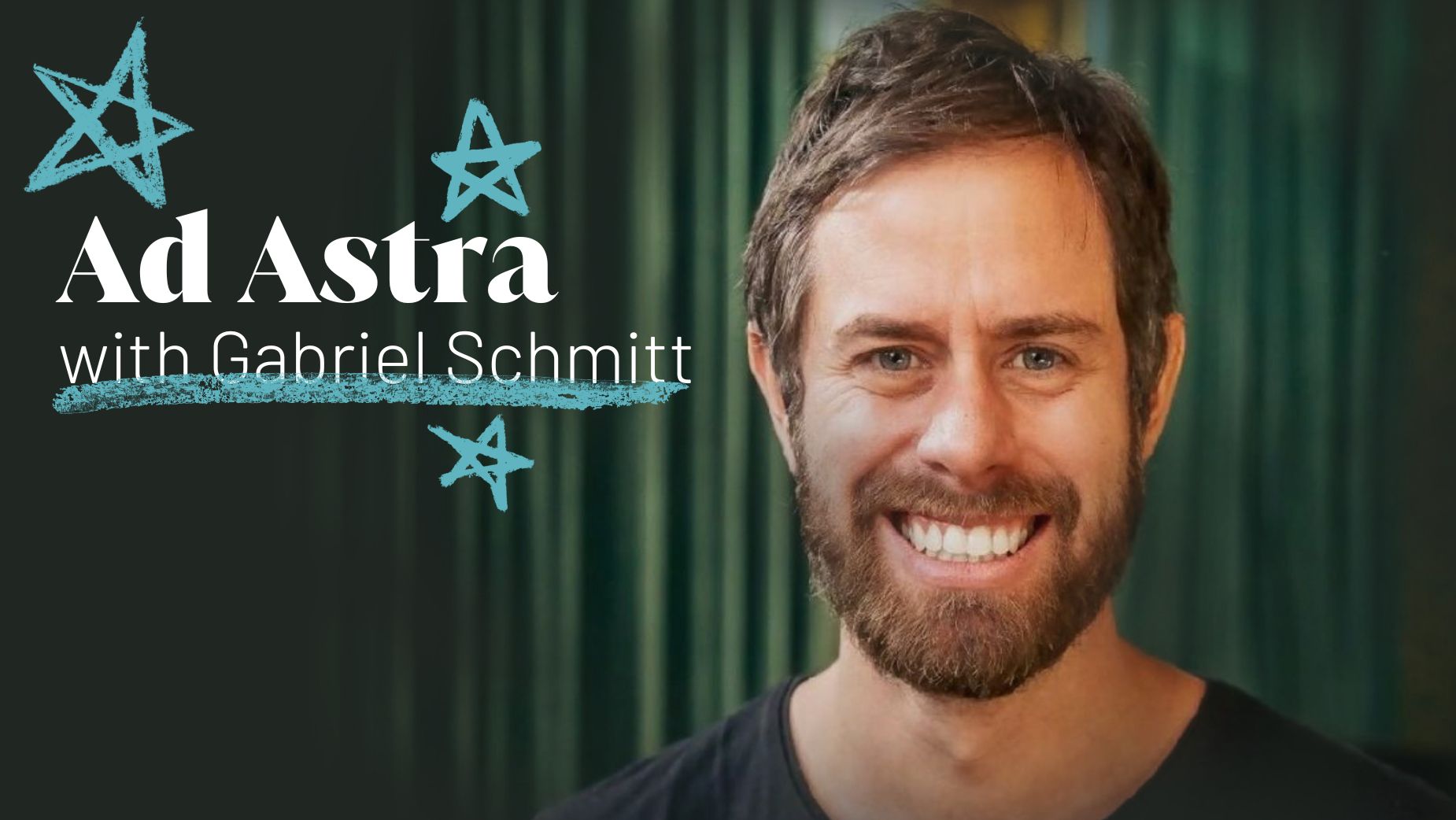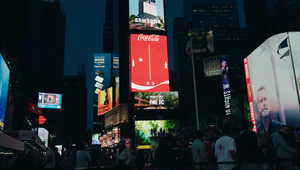
Ad Astra: Gabriel Schmitt’s Creative Synapses

As a little boy, Gabriel Schmitt wouldn’t just watch Disney films. He’d analyse them, breaking them down, figuring out the arcs. Even as a kid, he understood that the movies would try to make him feel a sequence of emotions that followed a pattern of ups and downs that would, eventually, resolve in a comforting, neatly tied bow.
“That’s also a trait I have today because I think I’m a very analytical kind of creative. I like to be very process oriented and to have a really tight framework so then we can have fun.”
That trait, or rather as Gabriel describes it, that ‘crash’ of traits, between the artistic and the analytical, was baked in from the get go. He grew up in a family of creative people, surrounded by professional artists, musicians, psychologists, not to mention his poet grandfather. And then there was his dad, a marketing executive who brought the ‘type A’ personality and logical thinking style.
With that blend, it’s perhaps little surprise that he recently became the global chief creative officer of an advertising network renowned for being ‘famously effective’. Gabriel is obsessed with creative ideas that solve clearly defined and deeply considered business problems. “In my opinion, famously effective is the best, clearest North Star that we have in this industry. Because in our best days, we’re all doing famously effective work, which, in a nutshell, is using creativity for business growth,” he says. He joined the agency in March 2023 and talks passionately about his joy collaborating with Grey’s global CEO Laura Maness and global CSO Jonathan Lee.
This global vantage point is a thrilling place to be and Gabriel says it’s a humbling experience dropping in with the teams around the world, absorbing, learning and supporting. The day we meet, he’s just off a call with the team in Malaysia. It’s all a long way from the thoughtful little boy with a critical eye for a Disney movie and ambitions to become a goalie.
Gabriel was born in Brazil, but a few months later, his father whisked him and the family to Colombia for a new posting at Unilever. That meant that Gabriel’s first language was Spanish, and when he returned to Brazil, he says his Portuguese was ‘weird’. However, he thinks that multilingual youth laid some important foundations.
“When I started learning English a few years later, I think it was easier for me because my ear was already used to weird languages. I think also what it does, if you’re writing from the get go, is it helps to have some interesting synapses or connections because there are so many cultures and languages going on.”
Gabriel’s writerly tendencies started to emerge in his teenage years when, after a few heartbreaks, he started to write poetry. His high school teacher was so impressed with his work that she thought that what he’d shared were works that his granddad had published. “I don’t know if it was positive reinforcement but that made me believe not that I was special but that I had some talent.”
That talent was soon channelled towards advertising when Gabriel’s father approved a campaign that won a bronze Lion at Cannes. Congratulatory bouquets of flowers arrived at the house and piqued his interest. However, making one’s way in advertising in Brazil in the early 2000s was no mean feat. It was a time when the country’s ad scene was fizzing and crackling with hot shops and a generation of bold, hungry talent. The atmosphere was electric – and highly competitive.
“You had to be really, really good and work really, really hard and I realised that it didn’t matter how talented I might be from a creative point of view, if I didn’t have the other side of things, the business acumen, there would be a ceiling.”
At college, where he studied communications, he was raring to go – there was only one problem. He didn’t really like the only other person in his class that wanted to go into creative. But he was a wannabe writer and this other chap was an aspiring art director, so they were forced to pair up for internships. Well, that art director was Thiago Cruz – who is CCO at Grey New York – and the pair have been the best of friends for 20 years.
Of course, back then, this exciting, international career was not even in Gabriel’s viewfinder. He was slogging his guts out to get a foothold in Brazil. After a placement at Euro RSCG, he landed an internship at what was then one of the coolest indies in the country, Age. After four months they offered him a junior role – but after so much hard work and high pressure Gabriel… froze.
“I got so paralysed. I was so nervous with the pressure and I got fired after six months, which crushed me. But I learned,” reflects Gabriel. For someone so motivated this crisis was a shock – but this experience of stumbling and being left to flounder has had a profound effect on him as a leader and mentor of creatives.
“I think my way to move forward was probably not the most optimal one because I just forced through it and I just made it work. This was 2005-6. It was not that long ago but it was a different era and I did not have any support while I was paralysed from anyone that should have supported me and maybe should have seen the talent that I could have. I was just disposable.
“I think the lesson for me is, you’ve got to understand that you are doing the best that you can. But you’ve got to understand that you probably have some blind spots that you have to work on in an objective way… but also, in the beginning of your career it’s not only on. You. You have to have the support system from the more senior people in whatever environment you’re in to help you get there… It’s always good to make sure you are supporting the people that really want to overcome their failures.”
These days, as a creative leader, Gabriel Schmitt believes in taking teams far beyond what they thought was possible, and understands that that can take a lot of from people. “But I think we can do that without breaking people,” he says.
After that initial bump, Gabriel soon hit his stride at Young & Rubicam, and then Dentsu. He was doing great work, Sao Paulo was a happening and inspiring city to live in, he had a girlfriend and he was beginning to make a name for himself as a rising star. He had no intention of going anywhere… and then FCB Chicago came calling. On the hunt for talent from Brazil, they hosted a competition, to be judged by an ECD from Chicago and the Brazilian CCO. At the encouragement of his creative partner, he entered his book, and four months later Gabriel had got married and moved to the US.
“I showed up in a creative department with 200 people and I’m kind of the second to last team, so that was a surprise. It was extremely different to Brazil,” he says. “It was a very different energy of people. People were very content with what they had. I got there with the immigrant’s thirst.”
Another thing that was notably different was that Gabriel found himself in a much more junior position than he had in Brazil. “The good thing about going to the US is that more times than not, you are ‘downgraded’. I know that’s annoying to foreigners. I was downgraded severely,” he says. “So I was able, with my partner at that point, to work the system really quickly and we ended up winning the first ever gold Lion for FCB Chicago in 125 years. That changed my career.”
After four promotions in five years, Gabriel moved to New York to take up a role at KBS (“the energy of New York and the pace of New York is much closer to my energy”). About that time Susan Credle – who Gabriel knew well from her time at Leo Burnett where she was based in Chicago – became the global CCO of FCB. She coaxed Gabriel back to the FCB family, this time FCB New York, which he says “objectively was not an interesting agency to be in in New York at that point in 2016”.
All that changed over the course of seven years. Gabriel worked his way up to chief creative officer and the agency went through a renaissance. There was a stream of genre-breaking work – Whopper Detour, for example, or Michelob Ultra campaigns like Courtside or McEnroe vs. McEnroe.
“You know where that comes from? It comes from being actually very business focused. I always say there’s no such thing as crazy ideas. There is on-strategy and there’s off- strategy ideas, which is why we spend so much time with strategists making sure that where we’re coming from is sound and interesting and is actually solving real business problems that are meaningful for the client. That’s the most important thing. And then, when you show up with a solution, it doesn’t matter what the solution is because it’s the solution to a problem that we all agreed on. That process also allows me to be super close to the clients. It’s the reason I was able to sell – I don’t like the word selling because it’s not selling but sharing.”
That’s Gabriel’s blend of logic and creativity shining through. He takes great care to understand where clients are coming from, the challenges they’re facing and that trust arises from setting and meeting expectations. A recent keynote he gave at Dubai Lynx was themed around the idea that if your client is expecting pizza, don't serve them sushi.
That strategic and business understanding is something that Gabriel is keen to nurture across the creative team – and that flow goes both ways. He finds that leaders, driven by that curiosity and passion for the business, often engage in that sort of cross-fertilisation naturally – but it has to be everyone’s responsibility.
“It’s important that the creatives become more and more business driven, that business people and the strategy people become more and more creative, and we all meet in the middle and then we kind of blend… when you’re talking to the C-suite, obviously more times than not, everyone’s wired that way. But the message doesn’t really trickle down to the ECD and so forth. I want the senior creatives, the ACDs, to be discussing strategy with their peers on the strategy side as much as I discuss it with Jonathan Lee, the global CSO of Grey.”
This insight applies to all creative people – not just creatives within Grey or even within advertising. Gabriel – who says he doesn’t care for owning too many things – has a carefully curated collection of Brazilian art in order to keep him connected to his birthplace. He’s connected to the art world and is friends with several artists whose careers have grown as his has. “On serious artists, there’s a parallel with our creative world, as in, you have to understand the business side of things, otherwise you don’t succeed.”
It all comes down to creating more possibilities for connections – or ‘synapses’. That quest to expand the pool of possibilities by seeking out opportunities to develop new ‘synapses’ is something that’s been part of Gabriel’s creative journey from the start – from those Disney cartoons and his bilingual childhood. These days, he keeps growing those synapses, even when he’s out walking his little dog Vilma – he listens to new music and his ‘library of weird things’ to see what inspiration strikes. And now, with the democratisation of AI becoming a reality, Gabriel’s positively buzzing about the almost infinite network of new ‘creative synapses’ that it will enable.
“I think what will happen at a societal level is that creative thinking will be a skill that will be more and more expected, not only from creative people but all sorts of people,” says Gabriel. “When you have Midjourney or ChatGPT and some smart prompts, you can create things or learn quickly. The connections, the synapses we’re all doing in our own heads and across society at large are much richer. I strongly believe that creativity is one of the most important skills that anyone could have. I think a creative doctor will be much better than a non-creative one. I think that a lawyer that applies creative thinking to their cases will have more success than one who doesn’t.”
“I think that in the short-to-mid term, that will make for a much more interesting society because we’ll all become forcibly more creative. And for us, the creatives, what that does is make our responsibility even bigger.”
Technology, he reflects, is just another partner, and at that partnership – when you get down to it – is the very human beating heart of creativity.
“There is this romantic, traditional idea of a creative working by themselves and just cracking the code and having that ‘eureka’ moment. I think there’s some truth to that but it is much easier to crack onto great ideas when you’re not by yourself.
“I think what will never, ever change and should not change, is the more inputs we have, the more interesting synapses we can make,” he says. ”Partnership will never go away. We do not do things by ourselves, it’s impossible – or at least it’s much, much harder to do things by ourselves. The more we connect with each other, the more dots we’ll connect, in fresh ways.”













